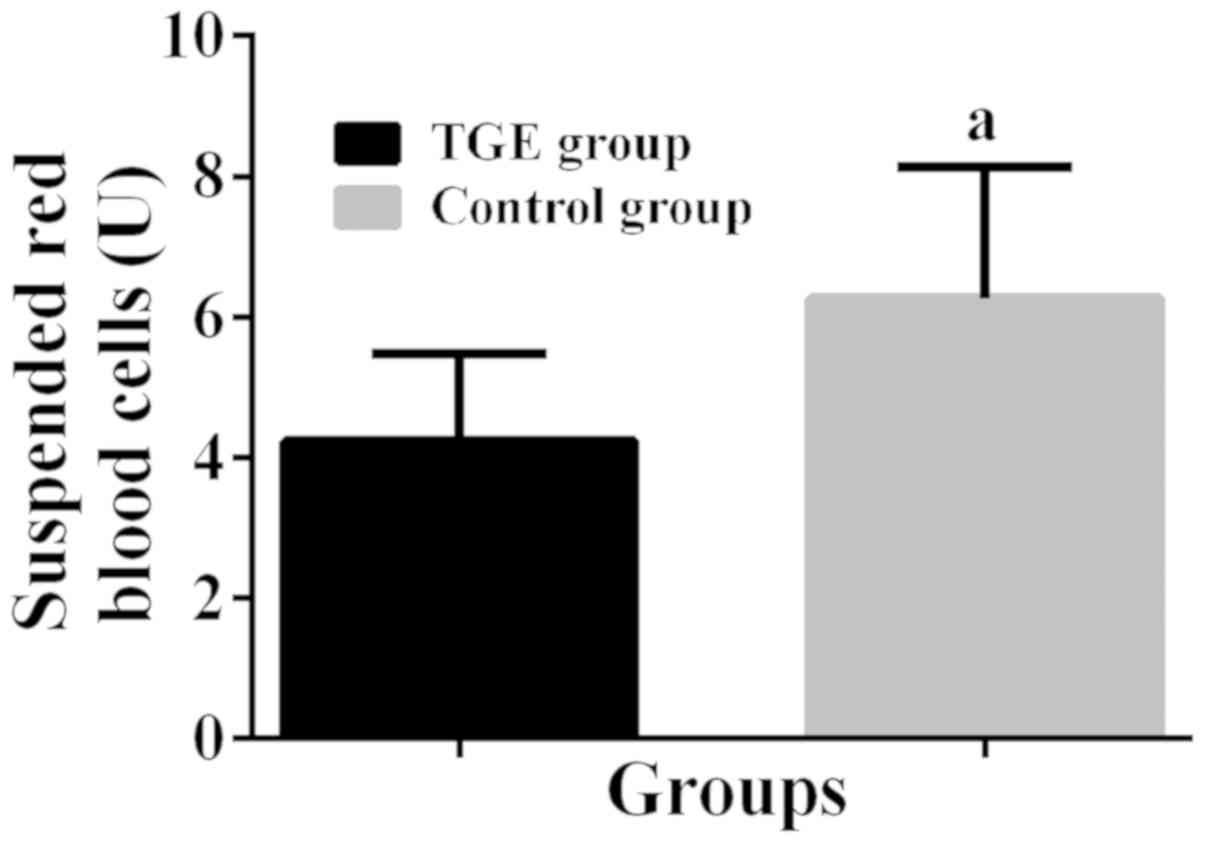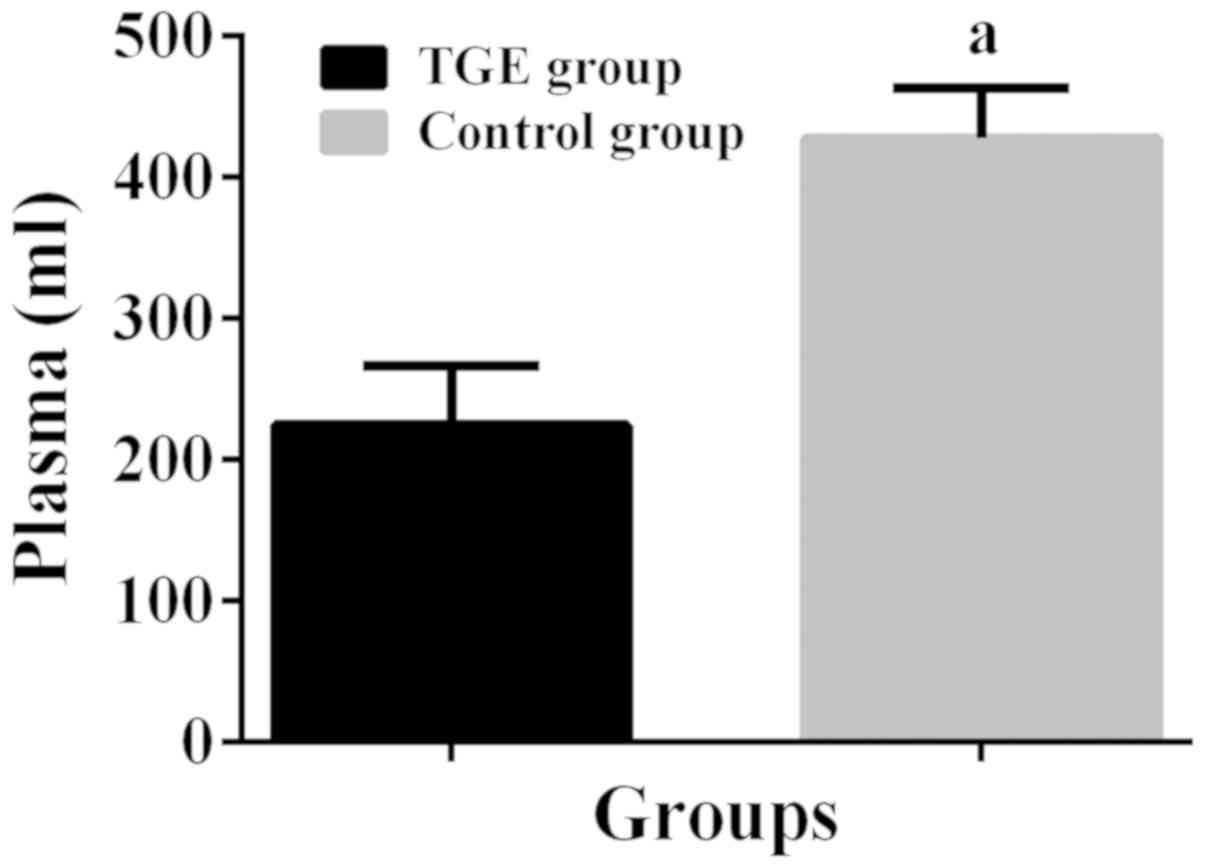|
1
|
Clark NP, Douketis JD, Hasselblad V,
Schulman S, Kindzelski AL and Ortel TL; BRIDGE Investigators, :
Predictors of perioperative major bleeding in patients who
interrupt warfarin for an elective surgery or procedure: Analysis
of the BRIDGE trial. Am Heart J. 195:108–114. 2018. View Article : Google Scholar : PubMed/NCBI
|
|
2
|
Paparella D and Whitlock R: Safety of
salvaged blood and risk of coagulopathy in cardiac surgery. Semin
Thromb Hemost. 42:166–171. 2016. View Article : Google Scholar : PubMed/NCBI
|
|
3
|
Drolz A, Horvatits T, Roedl K, Rutter K,
Staufer K, Kneidinger N, Holzinger U, Zauner C, Schellongowski P,
Heinz G, et al: Coagulation parameters and major bleeding in
critically ill patients with cirrhosis. Hepatology. 64:556–568.
2016. View Article : Google Scholar : PubMed/NCBI
|
|
4
|
Kim JL, Park JH, Han SB, Cho IY and Jang
KM: Allogeneic blood transfusion is a significant risk factor for
surgical-site infection following total hip and knee arthroplasty:
A meta-analysis. J Arthroplasty. 32:320–325. 2017. View Article : Google Scholar : PubMed/NCBI
|
|
5
|
Le Quellec S, Paris M, Nougier C, Sobas F,
Rugeri L, Girard S, Bordet JC, Négrier C and Dargaud Y:
Pre-analytical effects of pneumatic tube system transport on
routine haematology and coagulation tests, global coagulation
assays and platelet function assays. Thromb Res. 153:7–13. 2017.
View Article : Google Scholar : PubMed/NCBI
|
|
6
|
Rhee C, Lethbridge L, Richardson G and
Dunbar M: Risk factors for infection, revision, death, blood
transfusion and longer hospital stay 3 months and 1 year after
primary total hip or knee arthroplasty. Can J Surg. 61:165–176.
2018. View Article : Google Scholar : PubMed/NCBI
|
|
7
|
Hanafy AS, Badawi R, Basha MAA, Selim A,
Yousef M, Elnawasany S, Mansour L, Elkhouly RA, Hawash N and
Abd-Elsalam S: A novel scoring system for prediction of esophageal
varices in critically ill patients. Clin Exp Gastroenterol.
10:315–325. 2017. View Article : Google Scholar : PubMed/NCBI
|
|
8
|
De Pietri L, Bianchini M, Montalti R, De
Maria N, Di Maira T, Begliomini B, Gerunda GE, di Benedetto F,
Garcia-Tsao G and Villa E: Thrombelastography-guided blood product
use before invasive procedures in cirrhosis with severe
coagulopathy: A randomized, controlled trial. Hepatology.
63:566–573. 2016. View Article : Google Scholar : PubMed/NCBI
|
|
9
|
Abuelkasem E, Lu S, Tanaka K, Planinsic R
and Sakai T: Comparison between thrombelastography and
thromboelastometry in hyperfibrinolysis detection during adult
liver transplantation. Br J Anaesth. 116:507–512. 2016. View Article : Google Scholar : PubMed/NCBI
|
|
10
|
Marian AA, Bayman EO, Gillett A, Hadder B
and Todd MM: The influence of the type and design of the anesthesia
record on ASA physical status scores in surgical patients: Paper
records vs. electronic anesthesia records. BMC Med Inform Decis
Mak. 16:29–38. 2016. View Article : Google Scholar : PubMed/NCBI
|
|
11
|
Iba T, Gando S, Saitoh D, Ikeda T, Anan H,
Oda S, Kitamura N, Mori S, Kotani J and Kuroda Y: Efficacy and
bleeding risk of antithrombin supplementation in patients with
septic disseminated intravascular coagulation: A third survey. Clin
Appl Thromb Hemost. 23:422–428. 2017. View Article : Google Scholar : PubMed/NCBI
|
|
12
|
Rasmussen KC, Højskov M, Johansson PI,
Kridina I, Kistorp T, Salling L, Nielsen HB, Ruhnau B, Pedersen T
and Secher NH: Impact of albumin on coagulation competence and
hemorrhage during major surgery: A randomized controlled trial.
Medicine (Baltimore). 95:e27202016. View Article : Google Scholar : PubMed/NCBI
|
|
13
|
Douketis JD, Wang G, Chan N, Eikelboom JW,
Syed S, Barty R, Moffat KA, Spencer FA, Blostein M and Schulman S:
Effect of standardized perioperative dabigatran interruption on the
residual anticoagulation effect at the time of surgery or
procedure. J Thromb Haemost. 14:89–97. 2016. View Article : Google Scholar : PubMed/NCBI
|
|
14
|
Spahn DR, Spahn GH and Stein P:
Indications and risks of fibrinogen in surgery and trauma. Semin
Thromb Hemost. 42:147–154. 2016. View Article : Google Scholar : PubMed/NCBI
|
|
15
|
Gonzalez E, Moore EE, Moore HB, Chapman
MP, Chin TL, Ghasabyan A, Wohlauer MV, Barnett CC, Bensard DD,
Biffl WL, et al: Goal-directed hemostatic resuscitation of
trauma-induced coagulopathy: A pragmatic randomized clinical trial
comparing a viscoelastic assay to conventional coagulation assays.
Ann Surg. 263:1051–1059. 2016. View Article : Google Scholar : PubMed/NCBI
|
|
16
|
Yang T, Lu JH, Lau WY, Zhang TY, Zhang H,
Shen YN, Alshebeeb K, Wu MC, Schwartz M and Shen F: Perioperative
blood transfusion does not influence recurrence-free and overall
survivals after curative resection for hepatocellular carcinoma: A
Propensity Score Matching Analysis. J Hepatol. 64:583–593. 2016.
View Article : Google Scholar : PubMed/NCBI
|
|
17
|
Pohlman TH, Fecher AM and Arreola-Garcia
C: Optimizing transfusion strategies in damage control
resuscitation: Current insights. J Blood Med. 9:117–133. 2018.
View Article : Google Scholar : PubMed/NCBI
|
|
18
|
Qiu L, Wang DR, Zhang XY, Gao S, Li XX,
Sun GP and Lu XB: Impact of perioperative blood transfusion on
immune function and prognosis in colorectal cancer patients.
Transfus Apheresis Sci. 54:235–241. 2016. View Article : Google Scholar
|
|
19
|
Jiang L, Nick AM and Sood AK: Fundamental
principles of cancer biology: Does it have relevance to the
perioperative period? Curr Anesthesiol Rep. 5:250–256. 2015.
View Article : Google Scholar : PubMed/NCBI
|
|
20
|
Gary JL, Schneider PS, Galpin M, Radwan Z,
Munz JW, Achor TS, Prasarn ML and Cotton BA: Can thrombelastography
predict venous thromboembolic events in patients with severe
extremity trauma? J Orthop Trauma. 30:294–298. 2016. View Article : Google Scholar : PubMed/NCBI
|
|
21
|
Cybulska P, Goss C, Tew WP, Parameswaran R
and Sonoda Y: Indications for and complications of transfusion and
the management of gynecologic malignancies. Gynecol Oncol.
146:416–426. 2017. View Article : Google Scholar : PubMed/NCBI
|
|
22
|
Lawson PJ, Moore HB, Moore EE, Stettler
GR, Pshak TJ, Kam I, Silliman CC and Nydam TL: Preoperative
thrombelastography maximum amplitude predicts massive transfusion
in liver transplantation. J Surg Res. 220:171–175. 2017. View Article : Google Scholar : PubMed/NCBI
|
|
23
|
Kreutz RP, Schmeisser G, Maatman B,
Schaffter A, Sinha A, von der Lohe E and Breall JA: Fibrin clot
strength measured by thrombelastography and outcomes after
percutaneous coronary intervention. Thromb Haemost. 117:426–428.
2017. View Article : Google Scholar : PubMed/NCBI
|
|
24
|
Adler M, Ivic S, Bodmer NS, Ten Cate H,
Bachmann LM, Wuillemin WA and Nagler M: Thromboelastometry and
thrombelastography analysis under normal physiological conditions -
systematic review. Transfus Med Hemother. 44:78–83. 2017.
View Article : Google Scholar : PubMed/NCBI
|
|
25
|
David JS, Imhoff E, Parat S, Augey L,
Geay-Baillat MO, Incagnoli P and Tazarourte K: Use of
thrombelastography to guide posttraumatic hemostatic therapy: More
coagulation factor concentrates and less allogenic blood
transfusion? Transfus Clin Biol. 23:205–211. 2016.(In French).
View Article : Google Scholar : PubMed/NCBI
|
















